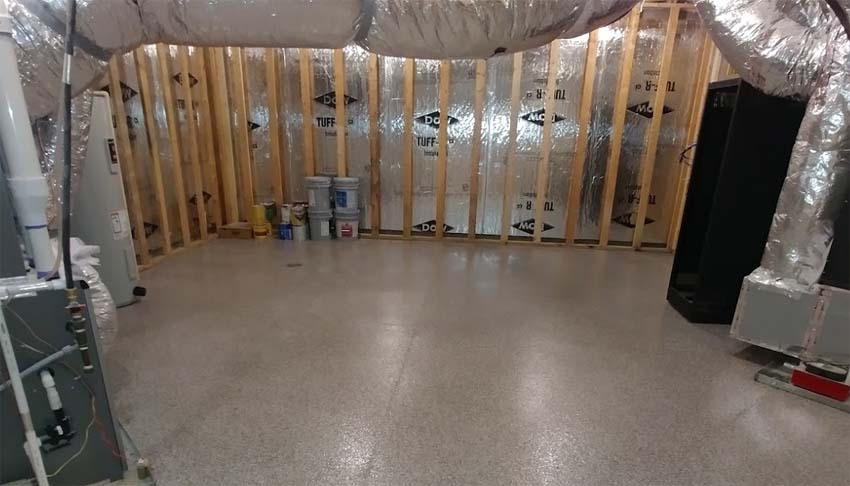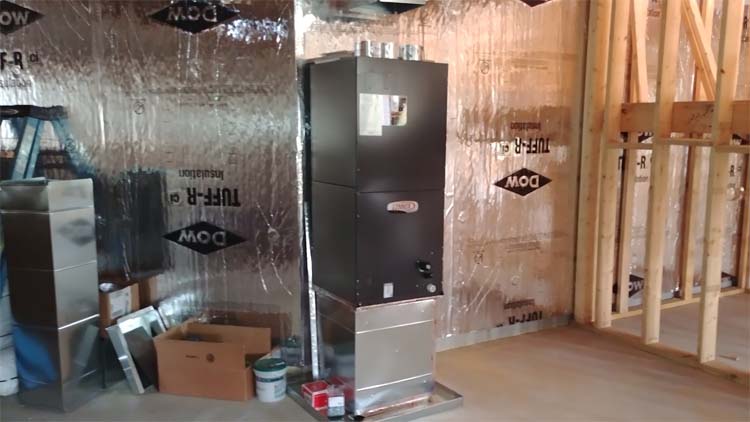How to Keep Your Basement from Smelling Like a Basement

Most basements have the damp and musty “basement smell.” Why is that? And does it have to be that way? The answer is “No.” It does not have to be that way. It’s not the concrete and earth you are smelling. It’s damp concrete and concrete block that smells like that. And it could also be mold and mildew.
But My Basement Is Dry. No Leaks. Why Does It Still Smell?
You might think that having a dry (waterproof) basement with no leaks would prevent this smell from developing. But the water that is causing this smell in your basement is not coming from outside. It is coming from inside your house in the form of condensation. It’s the water in the air (humidity) and the water that comes out of the air and condenses on cool surfaces that are making your concrete and concrete block damp and smell. And that condensation could be growing mold and mildew.
Condensation on Basement Walls and Floors Is the Enemy
We are all familiar with condensation forming on the outside of a glass of ice water or a cold beer can. This water is not leaking out of the glass, of course. It is coming from the air. Condensation forms on surfaces that are cooler than the “dew point” temperature of the air. Your cold glass or can is causing the condensation to occur because the temperature of the surface of the glass or can is lower than the dew point temperature of the air. The more humid the air, the more moisture can condense out of the air and onto cold surfaces. On a very hot and humid day, your glass of iced tea is likely to be sitting in a puddle on the table.
Basements tend to have more humid air than the rest of the house. And that air is not moving, so condensation can form even more easily. Without you being aware of it happening, condensation is forming frequently on the concrete floor and basement walls, just like on the glass of iced tea. You don’t see this water as easily as on the glass because those surfaces are not smooth like your glass of ice water. The irregular surface of concrete “hides” the moisture from view. But it is there. It is this moisture that’s condensing out of the air that causing the basement smell and it is making your basement seem damp and musty and not because of any actual water leaks.
A Two-Step Solution to Avoid the Basement Smell
This can be corrected. The solution to this problem is twofold. First, control the humidity in the air. This can be done but means of a dehumidifier. Also, get the basement air to circulate. Moving air is not as prone to condensation as still air. I like to mix or circulate the basement air with the air in the rest of the house. Not only does that improve the air quality in the basement, it lets you use the basement as a “heat sink” to reduce your heating and air conditioning costs. I talk about that in another article.
The second, and more important, part of the solution to prevent the basement smell is to keep the basement air from ever coming in contact with cold surfaces. The basement walls usually are the coldest surfaces in any basement. The walls are in contact with the outside air above ground, they are also in contact with the ground, which is cooler than your inside air temperature.
You want to prevent the warm, moist indoor air of the basement from coming into contact with the cool, hard surfaces of the basement walls. Here’s how I recommend doing that.

With unfinished basement walls, I always require 1 ½” thick insulation boards be adhered to the walls, tight against the concrete or concrete block. Floor to ceiling. No air gaps are allowed. The seams and the top and bottom edges are taped and caulked to prevent any air from getting behind the insulation boards. This gives your basement walls an insulating “jacket,” much like a beer “coozie” around a cold can of beer.
Building Code Check
Check your local Building Codes. Foam insulation boards that do not get covered with drywall or other finishes often must have a foil facing to meet the “flame-spread” requirements of the Building Code.
Insulation Must Be Tight to the Wall
A terrible and persistent construction mistake I’ve seen with finished basement walls happens when studs, fiberglass insulation, and drywall are installed against block or concrete basement walls, but not so tightly as to prevent air from coming into contact with the foundation wall itself. People, and even good builders, think they have isolated the cold foundation wall from the humid air, but they have actually created a trap for condensation and possible mold growth. The studs and fiberglass insulation do not adequately prevent air infiltration and humid air can get in behind the insulation and wreak havoc. This kind of construction can lead to significant mold growth that is out of sight, but no less harmful.
On basement walls that are going to be finished over with studs and drywall, I recommend (insist) that a ½” layer of rigid insulation board be adhered to the block or concrete walls with sealed edges before the studs, fiberglass insulation, and drywall are installed. That way no warm humid air can come into contact with the cool wall. No condensation can occur and no mold can grow. That means no basement smell can develop.
All of this requires some expense and some careful work. But the resulting dry, non-musty, and pleasant place your basement will become will be worth it in the end. You will actually be added useful space to your home.
I hope this information is helpful to you. You might want to get yourself a copy of my best-seller, Designing Your Perfect House. It is chockfull of valuable tips and advice that will save you many times the cost of the book on your house building or remodeling project. You might also like The Well-Centered Home: Simple Steps to Increase Mindfulness, Self-Awareness, and Happiness Where You Live. It will show you how to make your home a happy place.

